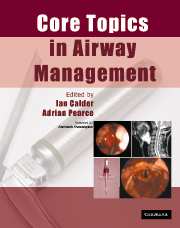Book contents
- Frontmatter
- Contents
- List of contributors
- Preface
- Acknowledgements
- List of abbreviations
- 1 Anatomy
- 2 Physiology of apnoea and hypoxia
- 3 Physics and physiology
- 4 Cleaning and disinfection of airway equipment
- 5 General principles
- 6 Maintenance of the airway during anaesthesia: supra-glottic devices
- 7 Tracheal tubes
- 8 Tracheal intubation of the adult patient
- 9 Confirmation of tracheal intubation
- 10 Extubation
- 11 Light-guided intubation: the trachlight
- 12 Fibreoptic intubation
- 13 Retrograde intubation
- 14 Endobronchial and double-lumen tubes, bronchial blockers
- 15 ‘Difficult airways’: causation and prediction
- 16 The paediatric airway
- 17 Obstructive sleep apnoea and anaesthesia
- 18 The airway in cervical trauma
- 19 The airway in cervical spine disease and surgery
- 20 The aspiration problem
- 21 The lost airway
- 22 Trauma to the airway
- 23 Airway mortality associated with anaesthesia and medico-legal aspects
- 24 ENT and maxillofacial surgery
- 25 Airway management in the ICU
- 26 The airway in obstetrics
- Index
6 - Maintenance of the airway during anaesthesia: supra-glottic devices
Published online by Cambridge University Press: 15 December 2009
- Frontmatter
- Contents
- List of contributors
- Preface
- Acknowledgements
- List of abbreviations
- 1 Anatomy
- 2 Physiology of apnoea and hypoxia
- 3 Physics and physiology
- 4 Cleaning and disinfection of airway equipment
- 5 General principles
- 6 Maintenance of the airway during anaesthesia: supra-glottic devices
- 7 Tracheal tubes
- 8 Tracheal intubation of the adult patient
- 9 Confirmation of tracheal intubation
- 10 Extubation
- 11 Light-guided intubation: the trachlight
- 12 Fibreoptic intubation
- 13 Retrograde intubation
- 14 Endobronchial and double-lumen tubes, bronchial blockers
- 15 ‘Difficult airways’: causation and prediction
- 16 The paediatric airway
- 17 Obstructive sleep apnoea and anaesthesia
- 18 The airway in cervical trauma
- 19 The airway in cervical spine disease and surgery
- 20 The aspiration problem
- 21 The lost airway
- 22 Trauma to the airway
- 23 Airway mortality associated with anaesthesia and medico-legal aspects
- 24 ENT and maxillofacial surgery
- 25 Airway management in the ICU
- 26 The airway in obstetrics
- Index
Summary
Effect of induction on the airway
The induction of general anaesthesia or sedation tends to result in hypoxia because of:
Airway obstruction. Maintenance of a patent upper airway is a complex physiological mechanism. Even minor depression of consciousness can result in obstruction.
Respiratory depression.
Decreased cardiac output.
Mechanism of airway obstruction
It is a usual practice to induce anaesthesia with the patient supine and nearly horizontal, which is the least favourable position for airway patency, but the most convenient for intervention. Relaxation of the musculature of the pharynx, face and neck allows the soft palate, tongue and glottic opening to approach the posterior nasopharyngeal wall. The greatest contribution to obstruction is believed to be at glottic and velo-palatine level.
Signs of airway obstruction
An obstructed upper airway results in increases in negative intrathoracic pressure during inspiration. This causes tracheal ‘tug’, intercostal and supra-clavicular recession and paradoxical or ‘seesaw’ breathing (if the airway is obstructed the chest sinks in and the abdomen rises – the opposite of normal).
Turbulent flow may occur in the upper airway, resulting in noise. The noise is worse on inspiration. The characteristic timbre of snoring (palatal, tongue and peri-glottic level obstruction) and stridor (glottic and tracheal level) are readily recognized with experience. Absence of noise does not mean that the airway is not critically narrowed and a completely obstructed airway is silent. Auscultation of the neck to assess airway patency is a valuable examination.
Secretions or foreign bodies in the airway may cause obstruction. The noise of secretions is characteristic. Foreign bodies in anaesthetic circuits (introduced by accident or malicious design) have resulted in tragedies. If airway obstruction occurs, the anaesthetist must ensure that the circuit and any artificial airway is patent.
- Type
- Chapter
- Information
- Core Topics in Airway Management , pp. 43 - 56Publisher: Cambridge University PressPrint publication year: 2005
- 2
- Cited by



